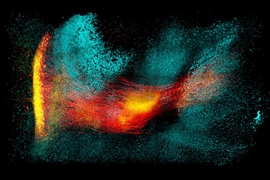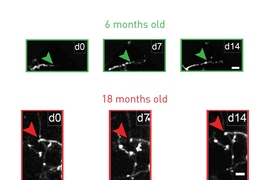The rat in a maze may be one of the most classic research motifs in brain science, but a new innovation described in Cell Reports by an international collaboration of scientists shows just how far such experiments are still pushing the cutting edge of technology and neuroscience alike.
In recent years, scientists have shown that by recording the electrical activity of groups of neurons in key areas of the brain they could read a rat’s thoughts of where it was, both after it actually ran the maze and also later when it would dream of running the maze in its sleep — a key process in consolidating its memory. In the new study, several of the scientists involved in pioneering such mind-reading methods now report they can read out those signals in real-time as the rat runs the maze, with a high degree of accuracy and the ability to account for the statistical relevance of the readings almost instantly after they are made.
The ability to so robustly track the rat’s spatial representations in real-time opens the door to a whole new class of experiments, the researchers said. They predict these experiments will produce new insights into learning, memory, navigation and cognition by allowing them to not only decode rat thinking as it happens, but also to instantaneously intervene and study the effects of those perturbations.
“The use of real-time decoding and closed-loop control of neural activity will fundamentally transform our studies of the brain,” says study co-author Matthew Wilson, the Sherman Fairchild Professor in Neurobiology at MIT’s Picower Institute for Learning and Memory.
The collaboration behind the new paper began in Wilson’s lab at MIT almost 10 years ago. At that time, corresponding authors Zhe (Sage) Chen, now an associate professor of psychiatry and neuroscience and physiology at New York University, and Fabian Kloosterman, now a principal investigator at Neuro-Electronics Research Flanders and a professor at KU Leuven in Belgium, were both postdocs at MIT.
After demonstrating how neural decoding can be used to read out what places are covertly replayed in the brain, the team began a series of technical innovations that progressively improved the field’s ability to accurately decode how the brain represents place both during navigation and in sleep or rest. They reached a first milestone in 2013 when the team published their novel decoding approach in a paper in the Journal of Neurophysiology. The new approach allows researchers to directly decipher hippocampal spatiotemporal patterns detected from tetrode recordings without the need for spike sorting, a computational process that is time-consuming and error prone.
In the new study, the team shows that by implementing their neural decoding software on a graphical processing unit (GPU) chip, the same kind of highly parallel processing hardware favored by video gamers, they were able to achieve unprecedented increases in decoding and analysis speed. In the study, the team shows that the GPU-based system was 20-50 times faster than ones using conventional multi-core CPU chips.
They also show that the system remains rapid and accurate even when handling more than 1,000 input channels. This is important because it extends the real-time decoding approach to new high-density brain recording devices, such as the Neuropixels probe co-developed by imec, HHMI and other institutions — think of a many electrodes recording from many hundreds of cells — that promise to measure cellular brain activity at larger scales and in more detail.
In addition, the new study reports the ability for the software to provide a rapid statistical assessment of whether a set of reactivated neural spatiotemporal activity patterns truly pertains to the task, or is perhaps unrelated.
“We are proposing an elegant solution using GPU computing to not only decode information on the fly but also to evaluate the significance of the information on the fly,” says Chen, whose graduate student, Sile Hu, is the new paper’s lead author.
Hu tested a wide range of neural recordings in brain areas such as the hippocampus, the thalamus and cortex in multiple rats as they ran a variety of mazes ranging from simple tracks to a wide-open space. In a video accompanying the paper, the system’s readout from 36 electrode channels in the hippocampus tracks the rat’s actual measured position in open space and provides real-time estimates of the decoded position from brain activity. Only occasionally and briefly do the trajectories diverge by much.
The software of the system is open source and available for fellow neuroscientists to download and use freely, Chen and Wilson say.
Prior experiments recording neural representations of place have helped to show that animals replay their spatial experiences during sleep and have allowed researchers to understand more about how animals rely on memory when making decisions about how to navigate — for instance to maximize the rewards they can find along the way. Traditionally, though, the brain readings have been analyzed offline (after the fact. More recently, scientists have begun to perform real-time analyses but these have been limited both in the detail of the content and also in the ability to understand whether the readings are statistically significant and therefore relevant.
In a recent major step forward, Kloosterman and two other co-authors of the new study, graduate students Davide Ciliberti and Frédéric Michon, published a paper in eLife on a real-time, closed-loop read-out of hippocampal memory replay as rats navigated a three-arm maze. That system used multi-core CPUs.
“The new GPU system will bring the field even closer to having a detailed, real-time and highly scalable read-out of the brain’s internal deliberations,” says Kloosterman, “That will be necessary to increase our understanding of how these replay events drive memory formation and behavior.”
By combining these capabilities with optogenetics — a technology that makes neurons controllable with flashes of light — the researchers could conduct what they call “closed-loop” studies in which they could use their instantaneous readout of spatial thinking to trigger experimental manipulations. For example, they could see what happens to navigational performance the day after they interfered with replay during sleep, or they could determine what temporarily disrupting communication between the cortex and hippocampus might do when a rat faces a key decision about which direction to go.
Hu is also affiliated with Zhejiang University in China. In addition to Hu, Wilson, Chen, Kloosterman, Ciliberti, and Michon, the paper’s other authors are Andres Grosmark of Columbia University, Daoyun Ji of Baylor College of Medicine, Hector Penagos of MIT’s Picower Institute, and György Buzsáki of NYU.
Funding for the study came from the U.S. National Institutes of Health, the National Science Foundation, MIT’s NSF-funded Center for Brains Minds and Machines, Research Foundation - Flanders (FWO), the National Science Foundation of China, and the Simons Foundation.










